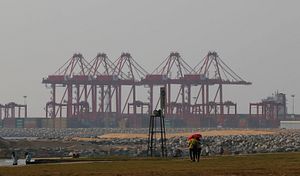By Pradumna B Rana and Xianbai Ji

The Indian geostrategist Brahma Chellaney is frequently credited with coining the term “debt trap diplomacy” in 2017. Chellaney asserted that the aim of China’s Belt and Road Initiative (BRI) was to saddle small nations with debt that they could not hope to repay, “leaving them even more firmly under China’s thumb.”
Since then, based on a review of just a limited number of cases and projects, many others have come up with similarly skeptical views on the BRI. The debt-trap diplomacy (DTD) thesis has, therefore, morphed into something approaching conventional wisdom.
The specter of debt-trap diplomacy has also been widely used by world leaders. For example, a bipartisan group of 16 U.S. senators in August 2018 expressed apprehensions about the BRI by citing “the dangers of China’s debt-trap diplomacy.” They noted that it was imperative for the United States to counter China’s attempts at leveraging foreign debt to advance geopolitical goals. Leaders in Japan and Australia, which together with the U.S. and India comprise the China-containing Quad bloc, also frequently use the term.
A recent Chatham House research paper by Lee Jones and Shahar Hameiri offers a robust challenge to the DTD thesis. Jones and Hameiri argue that the BRI reality is both messier and more nuanced. They argue that oftentimes controversial BRI projects were actually initiated by recipient governments, and that Chinese financial institutions were not coordinated enough to pursue detailed strategic objectives.
However, they too focus on the experience of only two countries, Sri Lanka and Malaysia, a very small subset of over 165 countries and international organizations that have signed a BRI memorandum of understanding (MOU) with China.
For our recent book, “China’s Belt and Road Initiative: Impacts on Asia and Policy Agenda,” we conducted an online perception survey of opinion leaders (defined as policymakers, academics and representatives of businesses and media) from a wide range of stakeholder countries including 26 Southeast, Central and South Asian countries that have signed a BRI MOU with China. Many of these countries have borrowed funds and are responsible for repaying BRI debt to China. Opinion leaders from Japan, Australia and India were excluded from our survey as they are not “stakeholders.”
More than 1,200 opinion leaders responded to our questionnaire. We also simulated a computable general equilibrium model, and conducted regional case studies to assess other economic impacts of the BRI.
The key findings of our book, which challenge the DTD thesis, are threefold.
First, after having considered both the benefits and costs of the BRI, on balance, 41.6 percent of the respondents believed that the BRI represented a net benefit for their countries, while only 17.8 percent said that it was a net cost. The strongest endorsements for the BRI came from South Asian countries like Bangladesh (64.5 percent), Pakistan (59.7 percent) and Nepal (58.8 percent), while opinion leaders from the Philippines were the least receptive to the BRI.
Second, on the DTD thesis itself, more than 42 percent of the respondents to our stakeholder survey rejected the alarmist narrative, although it is important to bear in mind that 30.6 percent felt otherwise. More than a quarter (27.3 percent) of the respondents had not made up their minds yet. Echoing the conclusions of the Chatham House report, several respondents highlighted various domestic factors (such as corruption and reckless propensity to borrow), rather than Chinese BRI financing, as being responsible for rising debt levels. Also, like Jones and Hameiri, several others felt that China’s financial system was too fragmented and would not be able to ensnare countries in debt traps.
Third, using the methodology developed by the Center for Global Development, which focuses on the level of public and publicly guaranteed debt-to-GDP ratio, we found that three out of the five South Asian countries for which data are available are presently facing debt distress. These are Sri Lanka, Pakistan and the Maldives. However, Sri Lanka owes more to Japan than to China, which holds only 3 percent of its debt. The country also borrows extensively from international capital markets, which represents roughly half its total debt holdings.
Similarly, Pakistan owes more to multilateral development banks and Islamic creditors (34 percent) than to China (only 6 percent). The Maldives appears to be an exception, but the country has been at a high risk of distress for at least a decade, with or without the BRI.
Summing up, in contrast to the views of many commentators and analysts, our recent book finds that although there are a large number of implementation and geopolitical issues confronting the BRI, the stakeholder countries generally feel that the DTD thesis is more a myth than a reality.
No comments:
Post a Comment